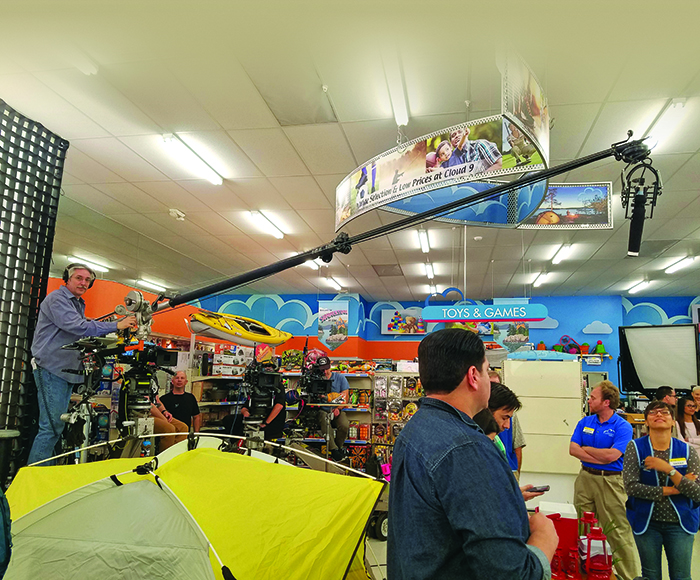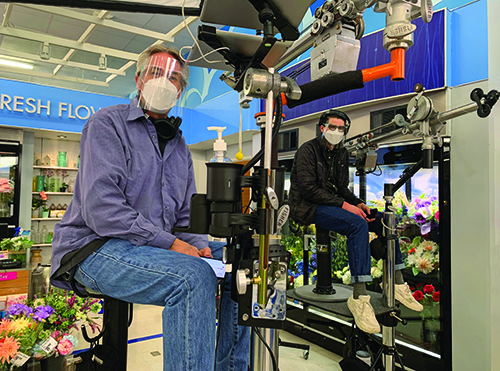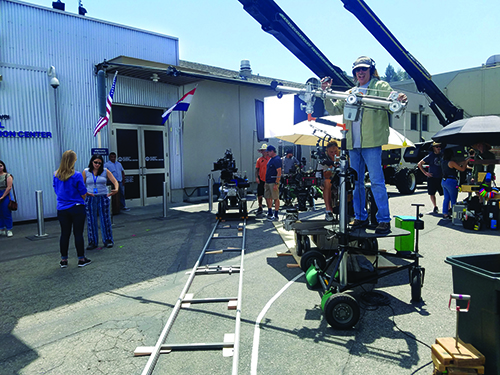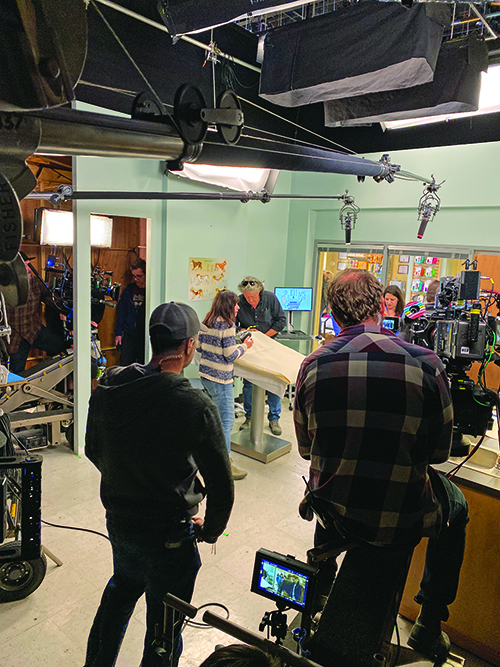by Richard Lightstone CAS AMPS

Aside from on-set COVID-19 safety protocols, one of the major health and safety concerns for Boom Operators in Local 695 is shoulder and back injuries due to the ever-increasing long takes while using boom poles.
In 1951, James L. Fisher designed a mechanical boom arm and base, known worldwide as the Fisher boom. Fisher booms were in use on most sets and locations for at least forty of the past sixty years. Changes in set design, the construction of four-walled sets and production’s reluctance to “fly walls,” made the use of the Fisher harder to employ on movie and television shows, although still prevalent on productions and sitcoms.
With the use of HD cameras, Boom Operators are forced to hold the boom pole for takes lasting between twenty and even forty minutes at a time. This is obviously untenable and unsafe.
Steve Cain, and his son Shannon, who are the Boom Operators of NBC’s Superstore, explained, “The first season we were living on eight and six-step ladders for the entire day. It was a really hard show, as we shoot with three cameras; two wing and a middle camera. The takes lasted a long time ’cause it was digital. They would reset and do several passes within each take without cutting.” Shannon continues, “You’re fully extended with a sixteen-foot pole pretty much the whole day.”
Sound Mixer Darin Knight went to production to explain that this was a health and safety issue, with the concern that someone could fall from the ladder and or drop the boom, injuring themselves or others. Takes were lasting fifteen minutes a piece with half a dozen shots for each scene. Darin successfully lobbied for one Model 3 Fisher boom with the Model 2 arm, that extends to sixteen feet. A second Fisher was added in season three and they operate with offset arms, extending the boom’s reach to almost nineteen feet each. Each boom is equipped with a microphone tilt hanger and Sennheiser 416’s.
The main set occupies two combined sound stages at Universal. Steve describes the scene: “This is a giant show, really, for sound, sometimes we have up to fourteen actors all on wireless mics, and two Fishers to move around.”
Shannon is busy wiring the cast and dealing with all the other equipment needs, and moves up to manage the second Fisher boom. Initially, the booms were hard wired to Darin, but this season they switched to a wireless configuration to avoid repeated returns to the sound cart, to stay within the COVID protocols.
Superstore incorporates a “Phase” system. Phase 1 is where camera will set up the shot and sound can move the booms in place. Phase 2 is for lighting, but often Steve and Shannon need to be there to move the Fisher base to accommodate set lighting. Phase 3 is for setting the background players, and Phase 4 is shooting.

Darin Knight’s sound cart and the two Fisher booms 
Steve and Shannon Cain, both booms with offset arms, monitor system, and correct
PPE
Steve Cain with an 816 in a blimp, better than a fishpole and a ladder with such a heavy microphone
Steve and Shannon were surprised by the crew’s acceptance of the Fishers. “A lot of the younger trainees and PA’s have never seen a Fisher boom,” Steve explains, “They don’t know what this is, more than half a dozen asked me if this is something I built myself. They had no concept of what this tool could do. I’d tell them, these were around before your parents were born.”
During the first season, seeing Steve and Shannon perched on ladders, the crew understood the need for the Fisher booms. The AD’s made the necessary compromises in placement of the Background Actors, and the Grip and Electric Departments worked to help them with their new tool. The Camera Operators were handheld in season one, then moved to dollies in the following season, making it better for Steve and Shannon on the Fishers.
The show’s DP, Jay Hunter, did some sound work early in his career, so he understood their issues. He was very supportive of Darin and the crew incorporating the Fisher booms. “He’s actually a fan of the Fisher as a piece of film equipment. He understands what a versatile tool it is, and how much more you can do with it than a fishpole,” explains Shannon.
“The hardest part I thought was getting the booms into the right position,” Steve continues, “realizing that this boom was a piece of gear that needed to be there, just like the dollies, just like the cameras. You had to claim your position and not feel awkward about telling people, you’ve gotta move that, as the boom has to be here.”
Unique to the show are the break room scenes with as many as thirteen cast members. Shannon and Steve are pleased at how they can cover those scenes with just the two booms. Steve said, “We have a couple of sets where we have to break it up into zones because of the size, and the way the dialog overlaps.”
The show is very unpredictable with the actors ad-libbing at will. Darin established a workflow of wiring the cast, but utilizing the Fishers in every scene. The booms can be raised high enough to reach over the shelving, so they can cover several aisles at a time. Shannon has often dollied the platform so Steve can cover many ‘walk and talks.’
They use two iPads, one to view the three cameras, and the second is for the script, using the Scriptation app. They have a talk-back system hooked up to foot pedals allowing them to communicate with Darin. The Fishers have proved most effective with two shots, as the actors are now at least six feet apart, although the camera angles cheat them as being much closer. “Even just two people talking, with COVID placement,” explains Shannon, “then the two overs, our typical setup for two people. We started to split those up, with two booms, just to catch ad-libs.”
Steve has mentored his son Shannon and speaks proudly of him, “He started with us about three years ago. I think the neat part about Shannon’s training on this show is that he’s learned to put mics and coordinate frequencies on the Venues, all the things that a Utility person would do. But he’s also got to watch how we’ve done it throughout our careers with two booms, and who’s covering who, telling a mixer how to set all that up. So, he has a really broad oversight of today’s sound.”

A typical Superstore setup: booms on each side of the center camera, with the two wing cameras (not pictured) shooting cross-coverage 
Two Fisher booms can work even small sets 
The Model 2 arm comes in handy with so many actors spaced six feet apart. 
A large split, no problem with two Fisher booms
Darin uses three Lectrosonics Venues, with fourteen wireless and three IFB channels for camera, the writers and the off-set feeds, with Shannon managing all of the frequency coordination. Due to the COVID protocols, the show is now shooting six-day episodes, but has a shortened order of thirteen from the original eighteen scheduled. Many actors are now wiring themselves, requiring Shannon to show them how to place them, switch them on and off, and mount the lavalier while Steve moves the Fishers into position.
Steve and Shannon took the Local’s Fisher boom training course from Production Mixer Eric Pierce, and have happily put their new skills to work on the show. They appreciate the accuracy and the versatility of the Fisher booms, as well as the safety they afford during long takes.
Local 695’s “One-on-One Intensive Fisher Boom Training” program is the only one of its kind, offering hands-on training on all of the Fisher microphone booms, including the 16-foot Model 2 boom and Model 3 Base, and the Model 7 boom and Model 6E Base, which comes in lengths of twenty, twenty-three, twenty-six, and twenty-nine foot. We go through safety, transporting, prepping, setting up weights, stringing and the use of accessories, and then we guide you while you get feedback from a live mic and work through an extensive set of exercises on the boom. The training is of course, important for Boom Operators and Utility Sound Technicians but also for Production Sound Mixers who need to know what the Fisher is capable of. Unfortunately, “One-on-One Intensive Fisher Boom Training” is not available at present due to COVID restrictions but we hope to be able to bring it back to you soon.